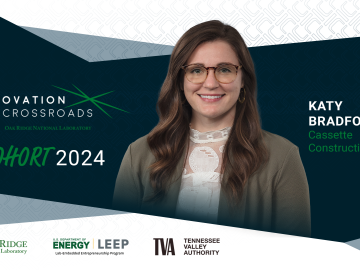
Filter News
Area of Research
Date
News Topics
- 3-D Printing/Advanced Manufacturing (19)
- Advanced Reactors (3)
- Artificial Intelligence (31)
- Big Data (15)
- Bioenergy (11)
- Biology (14)
- Biomedical (8)
- Biotechnology (7)
- Buildings (21)
- Chemical Sciences (22)
- Clean Water (5)
- Climate Change (25)
- Composites (8)
- Computer Science (29)
- Critical Materials (7)
- Decarbonization (26)
- Education (1)
- Emergency (1)
- Energy Storage (12)
- Environment (24)
- Exascale Computing (10)
- Fossil Energy (3)
- Frontier (9)
- Fusion (9)
- Grid (10)
- High-Performance Computing (22)
- Isotopes (15)
- ITER (1)
- Machine Learning (11)
- Materials (17)
- Materials Science (20)
- Mathematics (4)
- Microelectronics (2)
- Microscopy (2)
- Molten Salt (1)
- Nanotechnology (2)
- National Security (25)
- Net Zero (6)
- Neutron Science (16)
- Nuclear Energy (12)
- Partnerships (19)
- Physics (7)
- Polymers (5)
- Quantum Computing (13)
- Quantum Science (15)
- Security (3)
- Simulation (16)
- Space Exploration (3)
- Statistics (2)
- Summit (6)
- Sustainable Energy (21)
- Transportation (13)
Media Contacts

For the first time, ORNL will run equipment developed at its research facilities on a commercially available quantum network at EPB Quantum Network powered by Qubitekk to help validate the technology's commercial viability.

ORNL’s Matthew Loyd will receive a Department of Energy Office of Science Early Career Research award.

Katy Bradford is on a mission to revolutionize the construction industry and is the founder of Cassette Construction, a company in the newest cohort of Innovation Crossroads, a DOE Lab-Embedded Entrepreneurship Program node at ORNL. As an Innovation Crossroads fellow, Bradford and her company will receive technical, financial and networking support to successfully advance the company’s products to the marketplace.
After retiring from Y-12, Scott Abston joined the Isotope Science and Engineering Directorate to support isotope production and work with his former manager. He now leads a team maintaining critical equipment for medical and space applications. Abston finds fulfillment in mentoring his team and is pleased with his decision to continue working.

Scientists using high-resolution aerial scans and computational modeling concluded that wildfires, storms and selective logging have become key drivers behind rainforest carbon emissions, outpacing clear-cutting practices.

A new convergent manufacturing platform, developed in only five months at the Department of Energy’s Oak Ridge National Laboratory, is debuting at the International Manufacturing Technology Show, or IMTS, in Chicago, Sept. 9–12, 2024.

The "SNS LEGO Model Middle School Outreach Program" invites middle school students to build a LEGO model of the SNS, a major scientific accelerator. This engaging initiative aims to teach students about STEM careers and the inner workings of the SNS through hands-on construction and interactive lessons. Launching next spring, the program seeks to inspire interest in science and engineering among young learners.

ORNL has partnered with Western Michigan University to advance intelligent road infrastructure through the development of new chip-enabled raised pavement markers. These innovative markers transmit lane-keeping information to passing vehicles, enhancing safety and enabling smarter driving in all weather conditions.

On Feb. 15, 2024, the one billionth item, also known as an “occupancy,” was scanned at the Port of Aqaba, Jordan, one of the early sites where radiation detection equipment was installed. This milestone shows the extent of countries committed to preventing the spread of radioactive material through the amount of data volunteered to ORNL for continuous improvement. As adversaries push the limits of smuggling dangerous material, this collaboration pushes back through science-backed analysis.

As high-tech companies ramp up construction of massive data centers to meet the business boom in artificial intelligence, one component is becoming an increasingly rare commodity: electricity. Since its formation in 2004, the OLCF has fielded five generations of world-class supercomputing systems that have produced a nearly 2,000 times reduction in energy usage per floating point operation per second, or flops. With decades of experience in making HPC more energy efficient, the OLCF may serve as a resource for best “bang for the buck” practices in a suddenly burgeoning industry.


